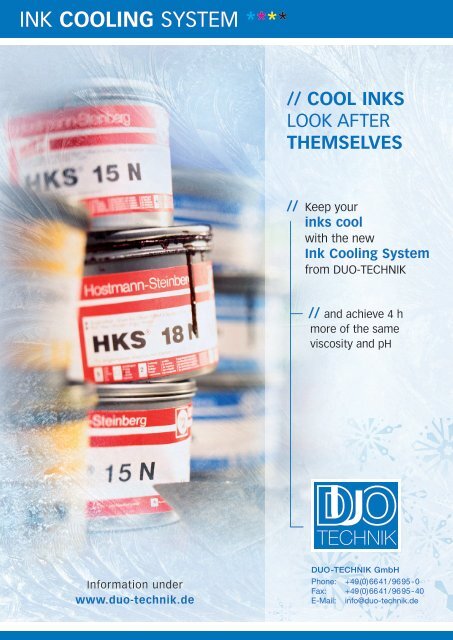INK COOLING SYSTEM **** - Duo-Technik GmbH
INK COOLING SYSTEM **** - Duo-Technik GmbH
INK COOLING SYSTEM **** - Duo-Technik GmbH
Create successful ePaper yourself
Turn your PDF publications into a flip-book with our unique Google optimized e-Paper software.
<strong>INK</strong> <strong>COOLING</strong> <strong>SYSTEM</strong> <strong>****</strong><br />
Information under<br />
www.duo-technik.de<br />
// COOL <strong>INK</strong>S<br />
LOOK AFTER<br />
THEMSELVES<br />
// Keep your<br />
inks cool<br />
with the new<br />
Ink Cooling System<br />
from DUO-TECHNIK<br />
// and achieve 4 h<br />
more of the same<br />
viscosity and pH<br />
DUO-TECHNIK <strong>GmbH</strong><br />
Phone: +49(0)6641/9695-0<br />
Fax: +49(0)6641/9695-40<br />
E-Mail: info@duo-technik.de
COLOR MANAGEMENT<br />
// Which factors need to<br />
be monitored?<br />
// Viscosity<br />
// PH<br />
// Temperature<br />
With the right viscosity the converting of the inks are improved.<br />
We suggest: for inks: 22-23 sec. Ford cup 4;<br />
for water based varnishes: 20-21 sec. Ford cup 4.<br />
The adhesion of the ink onto the sheet will be improved with the correct<br />
pH-value. In addition the drying results will be improved, too. Basically, the<br />
pH-value should decline from printing unit 1 to the last printing unit. The<br />
pH-value of the first printing unit should be 9-9,5 and should be dropped by<br />
0,2 per each further printing unit. However, it should never be lower than 8.<br />
The ink temperature is influenced by the ambient temperature and the<br />
friction of the inks in the ink circulation of the printing machine. With a fix<br />
temperature the change of viscosity and pH can be controlled and kept on<br />
a stable value. The temperature should be set between 20 and 22 °C (see<br />
chart 1).
<strong>INK</strong> <strong>COOLING</strong> <strong>SYSTEM</strong> <strong>****</strong><br />
The systems temperature control, viscosity control and pH control are modular<br />
concepts. This means that you can decide which system is the right one<br />
for your needs. The following examples make clear when and which combination<br />
is reasonable for you.<br />
Initial position 1: For each job change a new ink with adapted viscosity and<br />
pH is brought to the printing machine. Here, a ink cooling system is sufficient<br />
to hold the viscosity and the pH steady until the end of the printing job.<br />
Initial position 2: You produce mainly with the base colours without changing<br />
these at a new job. Here, we recommend installing all systems.<br />
With consideration of the results of the test series for ink cooling it has to<br />
be the goal to reach the aim temperature as fast as possible and keeps then<br />
the temperature stable for the rest of the time. With the <strong>Duo</strong>-<strong>Technik</strong> ink<br />
cooling it is possible to bridge a temperature gap of 10 °C in only 3 minutes.<br />
Furthermore as a result of our own ink circulation we are reducing the micro<br />
foam building. The following technical facts are characterizing the system:<br />
• The ink cooling is working with a central cold water unit (3-5 °C)<br />
• The electrical connection is only 1,5 KW for each printing unit<br />
• The cold water is pumped through a double-walled heat exchanger<br />
until the goal temperature is reached<br />
• With a separate ink circulation continuously ink is brought through<br />
the heat exchanger<br />
• The total system is connected with the cleaning system of the printing<br />
machine that no further actions for cleaning has to be taken place<br />
// Which system is the right<br />
one for me?<br />
// THE DUO-TECHNIK<br />
<strong>INK</strong> <strong>COOLING</strong>
VISCOSITY CONTROLS<br />
IS THE 2ND STEP? Viscosity is a proportion to measure the capability of the flow of a fluid. The<br />
higher the viscosity is the less the capability of the flow is. There is no defined<br />
dimension unit for the viscosity. Several dimensions are common: Centi Poise<br />
-> 50 [mPa*s]; Poise -> 0,5 [P]; DIN-Cup 4 -> 16 [s]; Pascalsecond -> 0,05<br />
[Pa*s]; Engler -> 6,62; Ford-Cup 4 -> 22 [s]. Means first of all the right system<br />
needs to be defined for each customer.<br />
DUO-TECHNIK <strong>GmbH</strong><br />
Phone: +49(0)6641/9695-0<br />
Fax: +49(0)6641/9695-40<br />
E-Mail: info@duo-technik.de<br />
Furthermore the viscosity depends on the temperature of the fluid (see chart<br />
2), means the viscosity is automatically decreasing with a higher temperature<br />
without any changes of the ink. In consequence of this we suggest to start<br />
with the temperature to have a base for the viscosity comparison.<br />
100<br />
ŋ/mPa s<br />
10<br />
1<br />
water<br />
ethanol<br />
mercury<br />
olive oil<br />
acetone<br />
-100 -50 0 50 100 150<br />
T/°C








